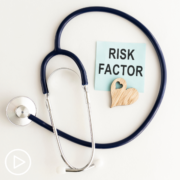How Can Public Policy Measures Reduce Gastric Cancer in High-Risk Populations?
How Can Public Policy Measures Reduce Gastric Cancer in High-Risk Populations? from Patient Empowerment Network on Vimeo.
What are some ways that gastric cancer disparities can potentially be reduced by public policy actions? Expert Dr. Joo Ha Hwang from Stanford Medicine explains the significance of USPSTF recommendations, how these recommendations have helped in screening guidelines of other cancers, and proactive patient advice to help close the gastric cancer disparity gap.
[ACT]IVATION Tip
“…I would encourage the listeners, especially if you have relationships with people in Congress, we need to reexamine making recommendations at a population level, and we really need to make recommendations based on individual risks, especially when we have clear-cut data as to who’s at high risk and what screening methods work.”
See More from [ACT]IVATED Gastric Cancer
Related Resources:

|

|

|
Transcript:
Lisa Hatfield:
Dr. Hwang, what public policy measures do you believe are crucial for reducing gastric cancer incidence and mortality, particularly in high-risk groups?
Dr. Joo Ha Hwang:
So, there’s one key thing that really needs to happen. And that is there’s a body called the United States Preventative Services Task Force. They make all the guideline recommendations for screening. And what is important about a USPSTF guideline recommendation is that insurance companies are mandated to cover these screening tests at no cost. So, for example, breast cancer screening is part of this, colon cancer screening is part of the USPSTF recommendations.
So, what we really need is the USPSTF to recommend gastric cancer screening in high-risk populations. And there are clear high risk populations in the United States. And again, these are mainly immigrants from high-risk regions. But for example there’s a recent study out that showed that immigrants from Korea, Korean Americans have a 12-fold higher risk of developing gastric cancer than the baseline population.
And that risk is actually higher than the risk of colon cancer in the baseline population. And the biologic, the USPSTF already recommends colon cancer screening for that threshold and colon cancer screening is much, much more invasive than upper endoscopy because it requires a prep as well as doing the endoscopy. So, there are clearly high-risk groups out there. We’ve tried to engage the USPSTF to help make these recommendations, but it appears that the population at risk is too small.
And so they’re reluctant to make any recommendations for such a small population. The problem I have with that is we are entering an era of what we call precision medicine or personalized medicine. And that’s where we look at each individual, we don’t look at it on a population level. We look at each individual and determine what’s your risk for each individual cancer or disease? And let’s treat you for that.
And the approach that the USPSTF takes is still more of a population-based approach and not a precision-based approach. And the activation that I would encourage the listeners, especially if you have relationships with people in Congress, we need to reexamine making recommendations at a population level, and we really need to make recommendations based on individual risks, especially when we have clear-cut data as to who’s at high risk and what screening methods work.
And so this is a challenge for patients, especially the immigrant population who’s at high risk for developing gastric cancer. There are very weak screening recommendations, and it’s typically not covered by insurance. And so there’s a high cost to the patient, where this really should be some. It’s an effective screening method by doing endoscopy or even H. pylori testing that should be covered, because cost-effectiveness studies have been performed that show that this is cost-effective.




![[ACT]IVATED Gastric Cancer Resource Guide](https://powerfulpatients.org/wp-content/uploads/ACTIVATED-Gastric-Cancer-Resource-Guide-180x180.png)




